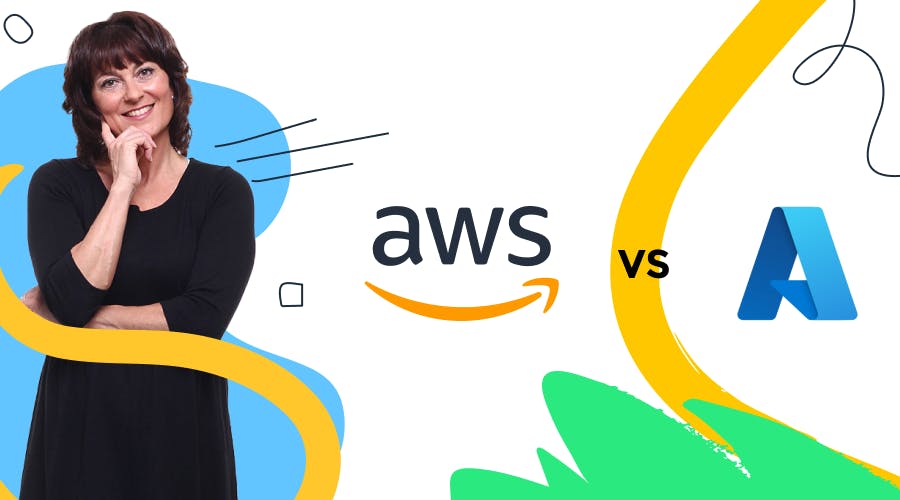In the ever-evolving landscape of cloud computing, AWS (Amazon Web Services) and Azure (Microsoft Azure) emerge as dominant forces, each offering a vast array of services and features (both offer around 80 services!)

Understanding the nuances between these platforms is crucial for businesses seeking to leverage the cloud effectively.
In this comprehensive comparison, we delve into key aspects including security, reliability, performance, services, DevOps, and storage to provide insights into the strengths and differences of AWS and Azure.
Security
Both AWS and Azure prioritize security, implementing robust measures to protect customer data and applications. The differences in Azure security vs AWS security are in the implementation.
AWS offers a range of security features including Identity and Access Management (IAM), Virtual Private Cloud (VPC), and GuardDuty for threat detection.
Identity and Access Management (IAM):
AWS Identity and Access Management (IAM) enables you to securely control access to AWS services and resources for your users. IAM allows you to manage users, groups, and permissions to grant only the necessary access needed for performing specific tasks, helping you maintain the principle of least privilege and ensuring the security of your AWS environment.
Virtual Private Cloud (VPC):
AWS Virtual Private Cloud (VPC) lets you provision a logically isolated section of the AWS Cloud where you can launch AWS resources in a defined virtual network. With VPC, you have complete control over your virtual networking environment, including IP address ranges, subnets, routing tables, and network gateways.
This allows you to create a secure and private environment within the AWS infrastructure, ensuring isolation and security for your applications and data.
GuardDuty:
AWS GuardDuty is a threat detection service that continuously monitors for malicious activity and unauthorized behavior in your AWS accounts and workloads.
Leveraging machine learning, anomaly detection, and integrated threat intelligence, GuardDuty analyzes billions of events across multiple AWS data sources to identify potential security threats such as unauthorized access, unusual API activity, and instance compromise.
GuardDuty provides actionable alerts and insights, helping you detect and respond to security incidents quickly and effectively.
Azure, on the other hand, provides Azure Entra ID, Azure Security Center, and Azure Sentinel for comprehensive security management.
Azure Entra ID:
Azure Entra ID is Microsoft's cloud-based identity and access management service. It allows organizations to securely manage user identities and access to resources in the cloud and on-premises.
Entra ID provides features such as single sign-on (SSO), multi-factor authentication (MFA), role-based access control (RBAC), and integration with thousands of applications.
It serves as the foundation for authentication and authorization in the Azure ecosystem, enabling centralized identity management and access control across various Azure services and applications.
Azure Security Center:
Azure Security Center is a unified security management and monitoring service that helps organizations protect their Azure resources and workloads. It provides continuous security assessment, threat detection, and security policy management for Azure virtual machines, networks, storage, and other Azure services.
Azure Security Center offers recommendations and best practices for improving security posture, as well as integration with Azure Defender for advanced threat protection capabilities such as vulnerability assessment, network security group (NSG) recommendations, and advanced threat detection.
Azure Sentinel:
Azure Sentinel is a cloud-native security information and event management (SIEM) service that provides intelligent security analytics and threat detection across the enterprise. It collects and analyzes security data from various sources, including Azure logs, Office 365, on-premises environments, and third-party security solutions, to detect and investigate security threats in real-time.
Azure Sentinel leverages machine learning, behavioral analytics, and automation to identify suspicious activities, correlate security events, and respond to security incidents effectively. It enables security operations teams to gain insights into their security posture, streamline incident response workflows, and improve overall cybersecurity defenses.
While both platforms adhere to industry standards and compliance certifications, organizations may find that one set of security offerings fits their needs better.
Reliability
Reliability is paramount in cloud computing to ensure uninterrupted service availability. AWS and Azure operate global infrastructures with redundant data centers, offering high availability and fault tolerance.
When comparing Azure vs AWS reliability, AWS's global footprint spans multiple regions and Availability Zones, providing resilience against failures. While Azure follows a similar approach with its regions and Availability Sets. Service Level Agreements (SLAs) for uptime are offered by both platforms, with Azure boasting slightly higher SLA percentages in certain cases.
Performance
When doing an AWS vs Azure performance comparison, metrics such as latency, throughput, and scalability are crucial considerations. AWS's extensive network infrastructure and content delivery network (CDN) contribute to low-latency, high-performance services.
Azure offers comparable performance with its global network backbone and CDN capabilities. Both platforms provide options for scaling resources dynamically to meet fluctuating demand, ensuring optimal performance for applications.
Services
AWS and Azure offer a vast array of services including compute, storage, networking, databases, AI/ML, IoT, and more. AWS boasts a range of services, including unique offerings like AWS Lambda for serverless computing and Amazon RDS for managed databases.
Azure, on the other hand, leverages its integration with Microsoft products and services, offering seamless interoperability for organizations with existing Microsoft investments. The choice between AWS vs Azure services often depends on specific service requirements and ecosystem compatibility.
DevOps
DevOps practices are integral to modern software development, enabling organizations to streamline collaboration and accelerate deployment cycles. Both AWS and Azure provide comprehensive DevOps toolchains, encompassing continuous integration, continuous delivery, and infrastructure as code (IaC) capabilities.
AWS offers services like AWS CodePipeline, AWS CodeBuild, and AWS CodeDeploy, while Azure provides Azure DevOps with features for version control, build automation, and release management.
The choice between AWS CodeBuild and Azure DevOps often aligns with existing technology stacks and workflow preferences. It’s worth noting that Microsoft also owns GitHub so there can be slightly better alignment between the actions and Azure.
Storage
Storage options in the cloud range from object storage and block storage to file storage and archival solutions. AWS offers Amazon S3 for object storage, Amazon EBS for block storage, and Amazon Glacier for archival storage.
Amazon S3 (Simple Storage Service):
Amazon S3 is an object storage service offered by AWS that provides scalable storage for data storage and retrieval. It allows users to store and retrieve any amount of data from anywhere on the web, with high availability, durability, and low latency.
Amazon S3 is commonly used for backup and restore, data archiving, content distribution, and application hosting. It offers features such as versioning, encryption, lifecycle management, and granular access controls to help users manage and secure their data effectively.
Amazon EBS (Elastic Block Store):
Amazon EBS is a block storage service provided by AWS that offers persistent block-level storage volumes for use with Amazon EC2 instances.
It allows users to create and attach storage volumes to EC2 instances to provide durable and high-performance storage for their applications and workloads.
Amazon EBS volumes are highly available and reliable, offering features such as snapshot backups, encryption, and volume resizing. They are suitable for a wide range of use cases, including database storage, file systems, and boot volumes for EC2 instances.
Amazon Glacier:
Amazon Glacier is a low-cost storage service offered by AWS that provides secure and durable storage for long-term data archiving and backup. It is designed for data that is infrequently accessed and requires long-term retention, offering low storage costs with flexible retrieval options.
Amazon Glacier provides three storage classes: Glacier Instant Retrieval, Glacier Expedited Retrieval, and Glacier Standard Retrieval, each offering different retrieval times and pricing tiers. It is suitable for storing data archives, backups, and regulatory compliance data that requires long-term retention and low-cost storage solutions.
Azure provides Azure Blob Storage, Azure Disk Storage, and Azure Archive Storage, each tailored to specific use cases and performance requirements.
Azure Blob Storage:
Azure Blob Storage is a scalable and cost-effective storage solution for storing large amounts of unstructured data such as documents, images, videos, and log files.
It provides a simple interface for uploading and accessing data over HTTP or HTTPS protocols, making it ideal for storing and serving content to web applications and mobile apps.
Azure Blob Storage offers various storage tiers, including hot, cool, and archive, each optimized for different access patterns and cost considerations. It also supports features such as lifecycle management, versioning, encryption, and access control to help users manage and secure their data effectively.
Azure Disk Storage:
Azure Disk Storage provides durable and high-performance block storage for Azure virtual machines and cloud applications.
It offers two types of disks: managed disks and unmanaged disks.
Managed disks are fully managed by Azure and offer features such as automatic replication, snapshots, encryption, and integration with Azure Backup and Azure Site Recovery.
Unmanaged disks require users to manage the underlying storage accounts manually. Azure Disk Storage provides different disk types and performance tiers, including Standard HDD, Standard SSD, Premium SSD, and Ultra Disk, allowing users to choose the appropriate disk configuration based on their performance and scalability requirements.
Azure Archive Storage:
Azure Archive Storage is a low-cost storage solution designed for long-term data retention and archiving. It provides a secure and durable storage platform for storing data that is rarely accessed and requires long-term preservation.
Azure Archive Storage offers flexible access tiers, including hot, cool, and archive, each optimized for different access patterns and cost considerations. Data stored in the archive tier has the lowest storage cost but requires longer retrieval times compared to the hot and cool tiers.
Azure Archive Storage is suitable for storing backup data, regulatory compliance data, and archival records that require long-term retention and cost-effective storage solutions.
Both platforms offer high durability, scalability, and data redundancy features, enabling organizations to store and manage data effectively in the cloud.
In the competitive landscape of cloud computing, AWS and Azure continue to innovate and expand their offerings, catering to diverse business needs.
While both platforms excel in terms of security, reliability, performance, services, DevOps, and storage, organizations must evaluate their specific requirements and preferences to make informed decisions.
Both platforms offer high durability, scalability, and data redundancy features, enabling organizations to store and manage data effectively in the cloud.
In the competitive landscape of cloud computing, AWS and Azure continue to innovate and expand their offerings, catering to diverse business needs.
While both platforms excel in terms of security, reliability, performance, services, DevOps, and storage, organizations must evaluate their specific requirements and preferences to make informed decisions.
Whether it's leveraging AWS's extensive service portfolio or Azure's seamless integration with Microsoft technologies, the choice between AWS and Azure ultimately depends on factors such as workload characteristics, budget considerations, and strategic alignment with business objectives.
Inventive’s team of experts will evaluate your current setup and create a tailored recommendation of services for your business. Reach out today!




